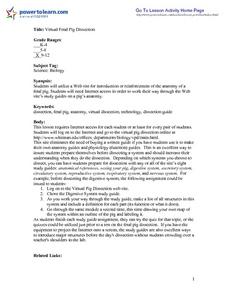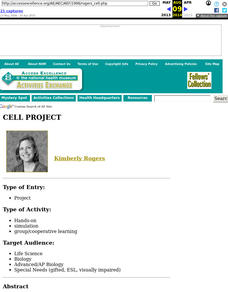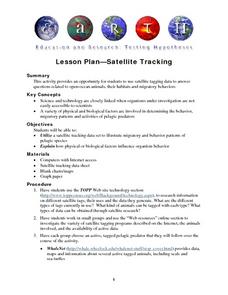Curated OER
Virtual Fetal Pig Dissection
Students use the internet to introduce themselves to the anatomy of a fetal pig. In pairs or individually, they work their way through a virtual dissection of a fetal pig while completing questions on a study guide. They also develop...
Curated OER
Genes: The Building Blocks of Life
Students examine various topics on genetics. Students explore the Internet to gather information on genetic testing, genetically engineered food, forensics, DNA and cloning. They research and determine the best way to fund each of the...
Curated OER
Microarrays: Chipping Away at the Mysteries of Science and Medicine
High schoolers research microarrays on the internet in cooperative groups. Students write an essay describing the use of microarrays in environmental research and in medicine.
Curated OER
Autism Spectrum Disorders: The New Rainbow
Learners conduct research into the area of Autism Spectrum Disorders. They use the internet and a variety of resources in order to obtain information. Students use the information to take part in a writing project of authoring a new...
Curated OER
Habitat Cards
Students discuss the relationship between a habitat and the environment. In groups, they use the internet to research the relationship between the animals and the habitat on their card. They present their information to the class to...
Curated OER
Cell Replication
Students use Internet activities and videos to understand the types of cells, their membranes, and the way that they reproduce. In this cellular biology lesson, students use the Internet to view videos and complete activities. They...
Curated OER
Cell Project
High schoolers investigate cells. They discover what cells are, where they are found, what they do and what they are made of. They construct a giant cell that is posted on the bulletin board.
Curated OER
Hickory Dickory Dock: The Biological Clock
Students investigate the effect of day length on animal migrations. They view a Powerpoint presentation, identify their own personal migrations and cues, answer discussion questions, and test a hypothesis about seasons.
Curated OER
Satellite Tracking
Students apply satellite tagging data to investigate questions related to open-ocean animals, their habitats, and their migratory behaviors. They determine how physical or biological factors determine organism behavior using a data...
Curated OER
A Reef of Your Own
Students study the reproductive strategies of reef building corals. For this coral reef lesson students describe the behaviors of reef building corals and their nutritional strategies.
Curated OER
Natural Selection Foldable
Pupils examine and identify examples of species that developed as a result of immigration, genetic drift, and adaptive radiation. They conduct Internet research and define key vocabulary terms, and use their species example on their...
Curated OER
NTeQ Science Lesson
Students produce a report on the types of dinosaurs found in our state of Texas using a word processing software.
Curated OER
Choose Your Defense: Spines, Vomit and Camouflage
Students investigate defensive mechanisms of insects and organisms. In this biology lesson, students draw imaginary caterpillars as well as imaginary parasites that will harm the caterpillar. Students utilize the Internet to discover...
Curated OER
The Seasons
Second graders determine the ways in which deciduous trees lose their leaves by investigating fallen leaves and how the weather changes throughout the seasons. They obtain knowledge about why and what causes the weather to change...
Curated OER
So, What's it Doing Today?
Students describe short-term variations in oceanographic parameters in the Gulf Stream. In this ocean habitats lesson students use satellite imagery to obtain information in the Gulf Stream.
Curated OER
What's Happening to Your Body
Students list the types of biological development that occur during adolescence and the nutritional, physical, and mental needs that support that development. They describe careers in the field of adolescent health.
Curated OER
An Introduction to Dichotomous Keys
Young scholars pretend to be shark biologists employed by the National Oceanic and Atmospheric Administration (NOAA) who have been flown into the coastal city of Sao Luis in Brazil because locals have noticed an unidentified shark at...
Curated OER
Trophic Relationships, Cycling of Chemicals, Human Impact on Ecosystems and Conservation
Learners explore how the energy flow through a system is related to trophic levels. They investigate how organisms affect the cycling of elements and water through the biosphere. Students participate in lab activities to observe ways...
Curated OER
Management of Commercial Fisheries, Part 3
Students search the Internet and write a research paper on the environment. In this investigative lesson plan students develop a paper on fisheries and management of them.
Curated OER
Scientist Simulation
Students envision the work of a research scientist, and the relationship between molecular biology and medicine. This activity allows students to imagine themselves working as research scientists by asking them to complete the end-steps...
Curated OER
How Appropriate is that Tree?
Young scholars identify trees and their environments using a dichotomous chart. In this exploratory lesson students use the Internet to identify conditions needed for the trees and what the climate is in their area.
Curated OER
Raptors: Senses and Influences
Young scholars compare the traits of humans to raptors. In this senses and beneficial traits lesson students create a newsletter and compare raptors to aircraft.
Curated OER
Now Take a Deep Breath
Learners research to answer questions related to deep sea diving. In this deep sea diving lesson, students answer questions on a worksheet using the Internet. They discuss pressure, gas laws, and the physiology of diving in the deep sea.
Curated OER
Evolution
Students research the theory of evolution and the controversy. In this evolution lesson students view a film on Charles Darwin then they write an essay about whether or not intelligent design should be taught in science class.

























